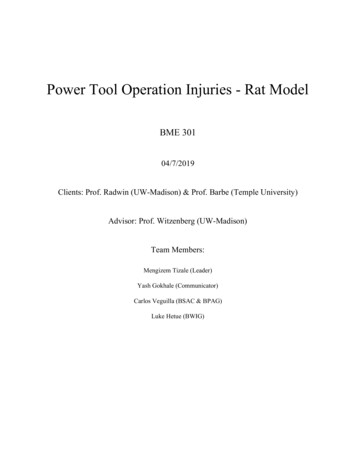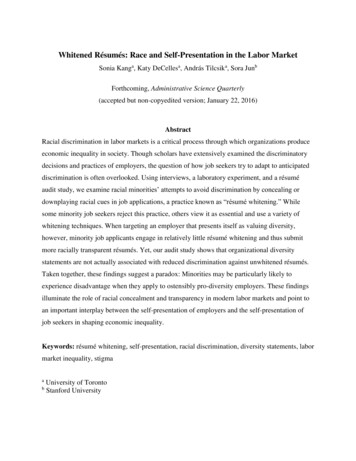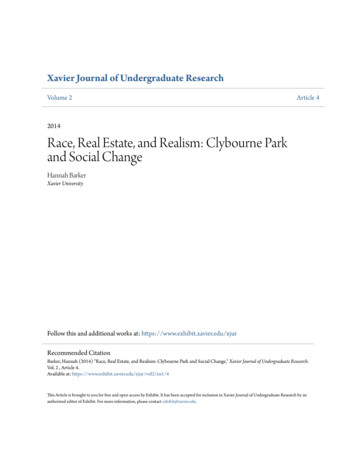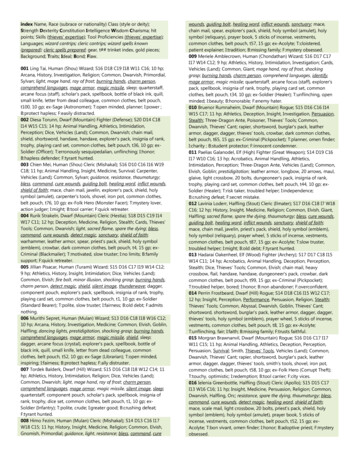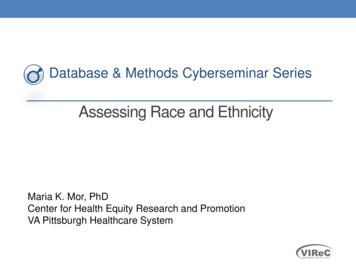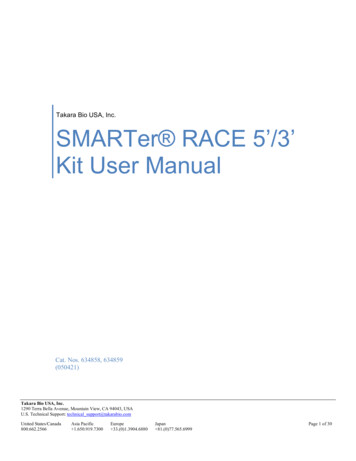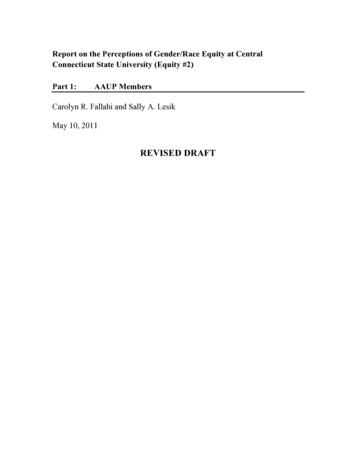
Transcription
Rat Race Escape Planby Andy TannerTanner Training LLC is providing this training and any related materials (including newsletters, blog posts and othercommunications) for educational purposes only. We are not providing legal, accounting, or financial advisory services,and this is not a solicitation or recommendation to buy or sell any stocks, options, or other financial instruments orinvestments. Examples that address specific assets, stocks, options or transactions are for illustrative purposes onlyand may not represent specific trades or transactions that we have conducted. In fact, we may use examples that aredifferent or the opposite of transactions we have conducted or positions we hold. This training is also not intended as asolicitation for any future relationship, business or otherwise, between the students or participants and the trainer. Noexpress or implied warranties are being made with respect to these services and products. All investing and trading inthe securities markets involves risk. Any decision to place trades in the financial markets, including trading in stock oroptions, is a personal decision that should only be made after thorough research, including a personal risk and financialassessment, and the engagement of professional assistance to the extent you believe necessary.R AT R A C E E S C A P E P L A N A N DY TA N N E R2
About Andy TannerAndy is a renowned paper assets expert and successful business owner and investorknown for his ability to teach key techniques for stock options investing. He serves asa coach to Rich Dad’s Stock Success System trainers and as the Rich Dad Advisor forPaper Assets.As a highly sought after educator, Andy has taught tens of thousands of investorsand entrepreneurs around the world. Students love Andy’s ability to make investingconcepts simple and understandable.He often speaks to students at the request of Robert Kiyosaki, showing how paperassets can fit into the Rich Dad system of investing. Andy was also key in helpingdevelop and launch Rich Dad’s Stock Success System, which teaches investorsadvanced technical trading techniques to profit from bull and bear markets.He is the author of two books: 401(k)aos exposes the hidden pitfalls of the popular401(k) investing plan, and Stock Market Cash Flow, a Rich Dad Advisor book on howthe average investor can use the stock market to generate regular cash flow and notjust buy and hold capital gains.Andy has also created an online investing course called The 4 Pillars of Investing.Investors who want to look over his shoulder as he invests with his own mentors eachweek will enjoy Andy’s Mentor Club.R AT R A C E E S C A P E P L A N A N DY TA N N E R3
What IsThe Rat Race?
You’ve probably heard the term Rat Race before. People will reference it whenthey say things such as, “I’m stuck in the Rat Race,” or “I hope that someday Ican get out of this Rat Race.”But what does this term really mean?For most of us, the Rat Race is a situation in which one day we wake up and feelas if we’re trapped by our circumstances. It’s a frustrating, hard-to-break lifestylethat usually forces us to stay in jobs we don’t always enjoy due to the multitude offinancial obligations hanging over us: the mortgage, rent, medical bills, filling the carup with gas, braces for the kids, day care, groceries, and so much more.Even those with seemingly good-paying jobs often feel very close to poverty whenthey’re caught in the Rat Race. I’m always surprised at how many people I speak toare just a paycheck or two away from financial ruin. As a result, they tend to stickwith the same jobs for fear of being poor.That’s how I describe the Rat Race with words. Now let’s look at what being stuck inthe Rat Race looks like with typical financial numbers.The place to begin is with a personal income statement and balance sheet. Thisis where we can see the money flowing into and out of someone’s life. It’s anilluminating (and sometimes painful) method of identifying the real financial situationsomeone is facing. Once we find the problem, it’s so much easier to find a solution.For our example, let’s say that every month your expenses total 5,000. This is theamount of money you need to pay to cover the cost of your lifestyle.So the first thing we need to figure out is this: how will you come up with 5,000every month?R AT R A C E E S C A P E P L A N A N DY TA N N E R5
Active Income vs.Passive Income
Most people solve this problem of paying their monthly bills by getting a job. Thisis something we call active income.In other words, we actively exchange our work for money. It doesn’t matter if thework is manual labor or more skilled brain work. With a job, you are relying onsomeone else to keep you employed so the money continues to flow into your bankaccount. If the job ends, so does your money. And when the money ends, you have noway to pay those monthly bills. Thus, the Rat Race begins.When we think of retirement, most people imagine the day when they no longer needto go to that job anymore. It usually occurs somewhere around the age of 65. By thattime, hopefully enough money has been saved to carry them through the retirementyears. For many people, retirement may never come. The nature of their own personalRat Race has somehow kept them from acquiring enough money to cover theirexpenses for their remaining days.On the other hand, you can also cover that 5,000 total of monthly expenses withsomething called passive income. For our discussion here, I want to focus on the typeof passive income we can generate by purchasing something called an asset.So instead of working to create cash, we want to explore what it looks like when wepurchase an asset that creates ongoing cash for us — every month, every year, for aslong as it fits our desires. In the coming chapters we’ll explore this in more detail.When we buy an asset, we place it in the Asset column of our balance sheet. Theseassets can include real estate, a business, commodities such as gold or oil wells, andpaper assets such as stocks.R AT R A C E E S C A P E P L A N A N DY TA N N E R7
There are two basic ways you can benefit from an asset:1.VALUE APPRECIATION. When you buy an asset for 10 and then over time thevalue increases to 100, you have an opportunity to profit. This kind of valueappreciation is called capital gain investing. A very common example of thisis putting money into a retirement account. Every time you put a chunk ofyour paycheck in there, you are hoping and praying that it will grow over timeenough to pay for your retirement years.2. CASH FLOW. You can also leverage an asset to provide you with regular cashflow. For example, you can buy a house and then rent it to provide you withmoney every month. This is the idea behind buying assets that can becomemoney machines to work for you.To get out of the Rat Race, we need to find a way to cover our monthly expenseswithout the need for active income. When our passive income is greater than ourexpenses, that’s when we can say that we are out of the Rat Race. This is whatfinancial freedom is all about.R AT R A C E E S C A P E P L A N A N DY TA N N E R8
The Forces Keeping YouIn The Rat Race
If all someone needs to do is buy the right kinds of assets, then why aren’t morepeople doing it?What are the forces that seem to be pushing on us to keep us in the Rat Race?FORCE #1: EDUCATIONLet’s back up a few years to see how these ideas are so deeply ingrained into ourminds. In school we are taught to follow the rules. We are shown a model of life likethis: go to school, get a good job and work hard, have a pleasant retirement, and livehappily ever after.In that scenario, education pushes us into the Rat Race. Additionally, when we followthese rules, we are never taught how to move to the other side. We aren’t given thetools or knowledge to get out of the Rat Race. That’s why most people can neverescape — they don’t know how.This affects people in all walks of life: laborers, desk job employees, and even doctorsand lawyers. It’s not about how many monthly bills you have or how much money youmake; it’s about how much passive income you can generate.FORCE #2: FEARAnother force that keeps so many of us from getting out of the Rat Race is fear. Themost common source of fear comes when we don’t understand something. Whenyou hear a strange noise in the night, the natural reaction is to be a little scared. Then,when you discover it’s just the cat walking around, you understand what’s happeningand the fear is gone.The same thing occurs when people think about getting out of the Rat Race. If wedon’t understand how it can happen for us, or that it’s not that difficult, then ofcourse we will feel a little scared of that unknown.For people who have jobs, the biggest fear is losing that job. When the job is gone, theflow of cash to pay the bills is also gone. To minimize that risk, we are taught variousmethods of finding and keeping a good job: learn new skills, be better than the otherguy, suck up to the boss, and all those other strategies. Yet we never really controlour risk, because as an employee someone else will always have the power to fire us.R AT R A C E E S C A P E P L A N A N DY TA N N E R10
Investors, on the other hand, see the situation differently. Since they have learned tohave money work for them, they have greater freedom of time and movement thanthose who hold jobs. That’s why their biggest fear is losing that freedom. It’s a fear ofhaving to answer to a boss. And the fear of having no control of whether or not you’llhave a job tomorrow.To minimize their risk of losing money, investors also work on gaining skills: they seekgreater education about the things in which they want to invest, in how money works,and how to make money even if the world is falling down around them. Investorsknow that knowledge truly is power – the more they learn, the more they earn.It’s important to ask yourself this question: Are you afraid of being an investor, orare you afraid of being an employee? Both of these fears can be overcome throughunderstanding what it takes to be successful. But only one of these paths willcertainly help you escape the Rat Race.FORCE #3: WORKAll success in life comes from hard work. Don’t be under the illusion that investing iseasy and doesn’t require any work from you. Yes, you will learn how to make moneywork for you. But until you master those skills, you will probably need to work moreas you enter the path of investing than you do as an employee.If you want to truly escape the Rat Race, but you are unwilling to put in the effort ofdoing what it takes, then I recommend that you stop reading right now and go playthe lottery. The business of creating passive income will require that you put in thetime and effort. And in due time, it will reward you for that sacrifice.As I speak to eager students around the world, I find that most are ready to do thework. They just need help getting pointed in the right direction. Most are workingfull-time jobs, so they figure out how to make time in the evenings and on weekendsto learn about creating passive cash flow. Those are typically the ones that taste thesuccess.These three forces that we have identified are the most typical ones we face.Individually, you may be naturally strong in one area, and weaker in the others.It’s different for everyone, of course. But when you are able to identify the forcesthat are most strongly working against you, that’s the first step in being able toR AT R A C E E S C A P E P L A N A N DY TA N N E R11
overcome those forces. With a good financial education, you can overcome your fearof investing. By learning to see your situation in a new way, you can gain insightsthat can break down the barriers that have held you back from accomplishing greatthings. And as you refocus your hard work into benefitting yourself instead of justyour employer, you can begin to reap the benefits that are the foundation of escapingthe Rat Race.When you think about it, it’s a little crazy how much we are willing to spend on acollege education. Right now in the United States, the average cost of a four-yeardegree is about 40,000 at the least expensive state universities and colleges. Ata private university, the same education will cost nearly 125,000. These are thedegrees that put you squarely in the Rat Race. Yet most people aren’t willing tospend any time or money to educate themselves on how to gain financial freedom bycreating their own income.R AT R A C E E S C A P E P L A N A N DY TA N N E R12
How To EscapeThe Rat Race
We know what the Rat Race is, and some of the forces that cause us to stay in it.Now let’s move forward and begin discussing how we can break free.As we saw, escaping the Rat Race requires us to buy assets that produce passiveincome. It’s important to understand that this passive income is new money comingto us as cash flow from our investments. We are not drawing from our savingsaccounts or other nest eggs. When the amount of passive income is greater than our 5,000 in monthly expenses, we are free. It’s that simple.Here are the four main asset classes we can choose from to help us reach our goal ofgetting out of the Rat Race once and for all: BusinessReal EstateCommoditiesStock (and related paper assets)With a true asset, the cash flow doesn’t deplete the way it does when you drawmoney from your savings. When you have a good business, a rental property, an oilwell, and a solid stock position, these can provide you with reliable income far beyondyour initial investment.This type of investing doesn’t rely on increasing your net worth. Instead, we want tofocus on building a solid foundation of new money cash flow that can sustain youover the long run. Not only is this possible, but it’s the exact strategy used by the richto maintain their lifestyle now and in the future. We’ll begin to explore some of thesemethods in the next chapter.Some investors choose just one asset class in which to specialize, and then devotetheir lives to learning and perfecting their skills to maximize their income. Otherschoose to participate in multiple asset classes.R AT R A C E E S C A P E P L A N A N DY TA N N E R14
Why Stocks MayBe The Right InvestmentMethod For You
When people consider investing in the stock market, they typically think of longterm retirement accounts or other buy-and-hold scenarios. Rarely do theythink of the stock market as a source of ongoing cash flow. Yet that’s exactly what itcan do for an educated investor.Start small. Perhaps the most attractive aspect of stock market investing is that itallows anyone to start small and scale up when you’re ready. Plus, you can get upand running in a short period of time. Starting a business or becoming a real estateinvestor are also great ways to help you escape the Rat Race. But they usually requirea large amount of money to get started. And they also require you to invest a bigchunk of time before they begin paying you back. With stocks, you have very littleoverhead and can start with very little money. Then you can scale it up as you grow.Flexible. When you invest in stocks, however, you can still get started while workinga regular job and learning to invest by practicing in your spare time, because I’m NOTtalking about day trading or those other risky types of stock investing that force youto be glued to your computer screen. My style of stock investing allows someoneto get up early and put in a bit of time before they head out to work. Others preferdoing it after they get home in the evening. Since you don’t have to interact withpeople as you do with a business or real estate, it’s easy to fit it to your own schedule.No people skills required. With other types of business and investing, some peopleget nervous because they don’t have the sales skills necessary to succeed. You don’tneed that as a stock market investor. Anyone with average intelligence and a desire tolearn can gain the right skills and strategies used by successful investors.Liquidity. The liquidity of the stock market means that there are always buyers andsellers ready to act. You only need to learn how to set up your investments to benefitno matter if the market moves up, down, or sideways like top investors you hearabout in the news all the time.Leverage. To gain leverage in business or real estate, an investor needs to take ondebt. This isn’t a bad thing, but it can sometimes limit your ability to play in thosearenas. In the stock market, you can have tremendous leverage through the use ofoption contracts. These types of option contracts allow you to control large amountsof stock positions for pennies on the dollar. It can be a huge advantage for theeducated investor who knows how to safely use options for steady cash flow.R AT R A C E E S C A P E P L A N A N DY TA N N E R16
Agility. If the real estate market plunges or the economy goes into recession, thereis instantly a lack of buyers and your cash flow can dry up instantly. With stocks,however, there is always opportunity – no matter if the market plunges like it hasrecently, or if it spikes higher, or even goes in a boring sideways direction. That’s whatI mean by agility: the ability to profit in any situation you face.Free practice. One of my favorite aspects of stock investing is that you can learn howto do it without risking a single penny in a bad trade. Virtually all brokerage firmsoffer anyone a free account to sign up and learn to trade. It works just as if you hadreal money in your account — but it’s basically ‘pretend’ money. This is an ideal wayto practice the strategies and skills you learn through a proper training program. Noother type of investment I know of gives you this type of sandbox to play in and honeyour skills.When it comes to choosing the right type of investment vehicle for you, it’s importantto be thoroughly educated on the pros and cons of each. Stock investing offers youmany of the advantages shown above. But both real estate and business can offerbigger paydays than stocks – especially if you’re starting with a small stock account.And while there is also more competition in the stock market, that competition alsogives you the advantage of always having a buyer or seller in any situation.R AT R A C E E S C A P E P L A N A N DY TA N N E R17
How My Wife And IStarted Investing
For many years I had very little interest in the money I wasinvesting.Well, that’s not entirely accurate. I had a lot of interest in the future value of mymoney. And I had full faith that the Wall Street companies managing our funds werecompetent to take care of my money. I had full faith in them.But then something happened Remember the Dot-Com Bubble back around 1999-2000? My wife and I sure do. Wehad some retirement accounts just like most people. And then the market droppedlike a rock.We were dazed.What in the world happened? Why didn’t those Wall Street geniuses protect ourmoney better?We sat down and looked at our account statements. Half of our account value wasgone overnight. At that moment, we knew that something needed to change. Weneeded to learn what happened to our money, and how to prevent something likethis from happening again.As we started to learn about investing, we were blown away at what we discovered.It became clear to us that those Wall Street companies weren’t very good atmanaging our money. Even worse, they were charging us an arm and a leg for theirincompetent services.At that point, we dove in head first. My wife and I learned everything we could aboutmoney and investing. And when we had the basics down, we teamed up with amentor to guide us to make sure we were placing trades properly. It didn’t take longbefore we were able to do it on our own.Along the way, I also discovered what I was really good at: teaching! Over the yearsI have traveled the world teaching tens of thousands of investors how to gain thissame knowledge and follow these same strategies.R AT R A C E E S C A P E P L A N A N DY TA N N E R19
How Some Of The World’sBest Investors Use TheStock Market
As part of my involvement with Robert Kiyosaki’s’ book Unfair Advantage, heasked me to discuss the difference between amateur and professional investors.The difference is huge.With their lack of understanding, amateurs generally try to buy low and sell high.They try to time the market with very little training and experience. Amateur investorsbelieve they are diversifying their stock portfolios by acquiring stocks from differentsectors of the market, and hoping the overall market continues to go up during thenext twenty or thirty years until they retire. But when the entire market drops, it takesall stocks with it. That’s the reality of the stock market we now have.Yet the typical amateur investor doesn’t foresee that these days the market movesin cycles with regular crashes. These crashes can be catastrophic to an investor’saccount. It usually takes many years for an amateur’s account to recover from abig market crash, just in time for the next one. The type of dollar cost averagingmade popular by Wall Street and consumer investing publications only benefits theinvestment companies who manage these accounts. When the crash occurs, it’s theinvestor who is left with the painful losses.When we look at how professional investors exploit the stock market to earn profits,we see a variety of behaviors. With their solid understanding of how the market reallyworks, and the knowledge that they can’t control where the market heads, they typically use investing methods with a built-in safety net. The most commonly-used strategyfor them is to use the stock market in conjunction with the options market. Stocksbecome their main investment, while options are like the insurance they buy for thatinvestment. It’s very similar to real estate – you buy the property as the main investment, and then you purchase insurance to protect it. That’s why top stock marketinvestors know how to do the same thing with stocks and options. It’s not difficult atall, but it takes a basic understanding of how it works and how to use it for yourself.Warren Buffett is widely regarded as the greatest investor of all time. Virtuallyeverything he touches turns to gold, helping him become one of the richest men toever walk the earth. When you read his name in the newspaper, it’s usually about anew business that his company has acquired. That’s an important part of his strategy.But what most people don’t know is that Buffett is a very skilled stock and optionplayer. He uses them together to ensure that he profits no matter what direction themarket heads. And he protects himself so that his losses are minimal compared tothe size of his investment.R AT R A C E E S C A P E P L A N A N DY TA N N E R21
What I love about Buffett’s approach is that it can also work for any investor, even ifyou have a very small account. His approach is smart because you can sell optionsto create income for yourself. It’s very simple to set it up in such a way for you toactually get paid to buy stock. That’s my type of investing!In a nutshell, here’s how professional investors use options to create income: Whenthey find a stock they want to buy, they set up options trades to lock in the price theywant to buy it for. These options also create income for them until they actually buythe stock. As an added bonus, the options also protect their risk exposure just likeinsurance. If the stock price moves the wrong way, they will still get paid.As a summary to the difference between amateur and professional investors, ingeneral we can see: Amateurs seek to earn their money in stocks from capital gains(buying low and selling high), and to manage their risk by diversification. Professionals seek to earn their money with cash-flow strategies, andto manage their risk by using contracts – they sell options for incomeand they buy options for protection.R AT R A C E E S C A P E P L A N A N DY TA N N E R22
What This CanLook Like For You
Now I want you to see how anyone with a good, basic stock market investingeducation can do this kind of investing for themselves.Here’s what a typical investing move looks like for me on an average day. It’s abasic strategy called a covered call. Let’s say I find a stock that I want to buy at 100,and I’m willing to sell it when it reaches 105. So I decide to go for it and I purchasethe stock.That’s where an amateur investor would be finished with the investment. Just buy itat 100 and hope the price goes up.For us, however, we’re just getting started. With the stock in my account, the nextthing I do is sell a one-month option to another investor that allows her to buy thestock at 105, even if the stock jumps much higher than that. For this example, let’ssay that the going price for this option is 5. So I sell the option for 5 and pocketthat money — it’s all mine. And during that month, she can exercise the option at anytime to buy the stock at 105. If she doesn’t then I keep the stock. And I always keepthe 5 she paid for that option.At this point, one of three things will happen:1.The price of the stock could go down – If this happens, I will continue tosell options every month to collect ‘rent’ on my stock. Think of it like a housethat you rent out. It doesn’t matter how much the house is worth, there willalways be people willing to rent it.2. The price of the stock could go up – If it does, then I will sell the stock ata profit.3. The price of the stock could stay about the same – Similar to the pricegoing down, I can continue selling options to collect rent.That’s a very simple approach that I can teach new investors how to do it properly invery little time. And with a little practice, my students use this strategy for safe andsteady gains.Now let me show you a little more advanced example of how you can do this witheven less initial investment:R AT R A C E E S C A P E P L A N A N DY TA N N E R24
Instead of buying a stock, I can buy a long term option called a LEAPS. This allowsme to control the stock for about 30 — a huge discount over the full 100 price. It’smuch cheaper than a stock, yet still allows me to sell calls and collect the premiumsas rent. So I have less money in the game, yet my amount of profit is the same as ifI had bought the full stock. With just that one move, my profit percentage increasefrom 5% ( 5/ 100) to nearly 17% ( 5/ 30). And since it’s scalable, I can reinvest myprofits to grow the size of my account and how many LEAPS I can purchase. That’sone way to grow your ability to create steady cash flow that can help you escape theRat Race with very little initial investment.For many investors, including my students, a typical morning involves getting up,buying your stocks for the day, selling your calls, and then managing your riskassociated with those positions.When I first started investing, I really struggled trying to learn the safest and easiestways to implement these strategies. I went through a lot of trial and error, and mademany mistakes. As I eventually found good mentors to help guide me, I became quiteproficient at doing my own cash flow investments.The thing I love most is that it’s not difficult. I’m a regular guy with averageintelligence. I found that the difference is a willingness to dig in, learn the basics,and follow instructions. It can really be that easy.R AT R A C E E S C A P E P L A N A N DY TA N N E R25
What You Can BeginDoing Right Now
Ihope you have come to realize through reading this ebook that anyone can learnto escape the Rat Race.You don’t have to continue working at a job you hate for the rest of your life. Youdon’t have to be trapped in a situation that doesn’t inspire you.We have discovered that the key to escaping isn’t to work harder at what you arecurrently doing. Because the system we are in has created powerful forces that aredifficult to escape.The most important first step is to see that escaping the Rat Race is all about onething: working to create a passive income that is greater than your total monthly bills.That’s it.With that as a target, next you can determine what types of investing you want tolearn how to do in order to achieve that goal of creating new passive income. It’s notfree money, and it will require work. The difference is that you will be creating it onyour own, without relying on a job and a boss that can terminate your cash flow atany moment.If you want to get out of the Rat Race, don’t focus on the investment. Instead, followthis process: BE, DO, HAVE. A lot of people want to race ahead and ‘have’ a certaininvestment, or ‘do’ a certain investing action. But please follow this wise advice thatothers have given me. Learn to ‘be’ an investor first. Then you can begin to ‘do’ thework of investing. Finally, that will automatically show you what investment to ‘have.’You have to be a doctor before you can do surgery and have patients. You have to bea lawyer before you can do law and have clients. You have to be an investor beforeyou can do investing and have money and have cash flowing investments.Robert Kiyosaki has taught me this lesson many times. The journey out of the RatRace is really the journey of becoming a better you. It’s about helping you becomeeducated and confident in your future. As you step into this journey, you will answerthe question of “Who Are You?”You have to be an investor before you can do investing. And that comes with time andeducation. I think the reason people are taught that the stock market is scary and difficult to do on their own is because of Wall Street. They want us to think we’re too dumbto succeed on our own. But we’re not. I have learned this for myself. Now it’s your turn.R AT R A C E E S C A P E P L A N A N DY TA N N E R27
Over the next few days I will be sending you some cool videos that I have beenworking on. They will show you
develop and launch Rich Dad’s Stock Success System, which teaches investors advanced technical trading techniques to profit from bull and bear markets. He is the author of two books: 401(k)aos exposes the hidden pitfalls of the popular 401(k) investing plan, and Stock Market Cash Flow, a
